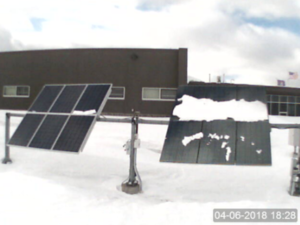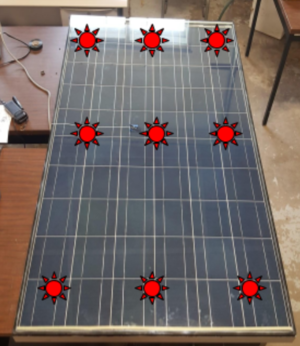No edit summary |
No edit summary |
||
| Line 3: | Line 3: | ||
[[File:EnergizedGlass.PNG|thumb|width=18|Fig 1: Control and Energized Glass solar modules at the Keweenaw Research Center]] | [[File:EnergizedGlass.PNG|thumb|width=18|Fig 1: Control and Energized Glass solar modules at the Keweenaw Research Center]] | ||
The goal of this project was to test the feasibility of placing heated glass on a solar module to remove snow. This project was preformed by the the [http://aee-mtu.org/teams/solar.html Alternative Energy Enterprise Solar Team] in the fall of 2017 and spring of 2018. The team worked with the [http://www.mtukrc.org/ Keweenaw Research Center] in Calumet, Michigan where twelve Yingli 240 solar modules were mounted. Six of the modules were the control group and were left unmodified. The other six modules were retrofitted with Energized Glass (EG), heated glass. | The goal of this project was to test the feasibility of placing heated glass on a solar module to remove snow. This project was preformed by the the [http://aee-mtu.org/teams/solar.html Alternative Energy Enterprise Solar Team] in the fall of 2017 and spring of 2018. The team worked with the [http://www.mtukrc.org/ Keweenaw Research Center] in Calumet, Michigan where twelve Yingli 240 solar modules were mounted. Six of the modules were the control group and were left unmodified. The other six modules were retrofitted with Energized Glass (EG), heated glass. The modules were connected to Enphase micro inverters and individual energy production could be verified. | ||
=='''Results'''== | =='''Results'''== | ||
[[File:TempSenLocation.PNG|thumb|Fig 2: Temperature testing locations for the Energized Glass to verify consistent temperature]] | [[File:TempSenLocation.PNG|thumb|Fig 2: Temperature testing locations for the Energized Glass to verify consistent temperature]] | ||
Three main experiments were preformed for this project. The first was to ensure that the Energized Glass was properly working. A temperature sensor was placed in nine locations on the solar modules to verify a consistent temperature across the surface. Although both data sets showed variance between panel zones, it was only by about a degree or so. This narrow variance in temperature was found to be sufficient for the scope of this project. From this, it was determined that the panel temperature is fairly constant throughout, and no additional temperature equipment was necessary for further experimentation. | |||
The second experiment was to determine the performance difference between the control and EG modules without snow. | The second experiment was to determine the performance difference between the control and EG modules without snow to see if the extra layer of glass caused a decrease in energy production. It was determined from the Enphase data that the EG decrease production by roughly 30%. | ||
The final experiment was to turn on the glass when they were covered in snow and seeing if that increased energy production. The team was not able to make a statistically valid conclusion when it came to the snow melt efficiency of the EG with the data collected during the semester. One test showed that EG produced more power than the control panels while another showed less (the number of tests were limited due to time and weather constraints). | |||
=="Recommendations for Future Work"== | |||
The AEE team's main recommendations is that more data is needed. More experiments on the glass will yield more conclusive results. Also, if possible place the materials to heat the glass on the Yingli existing glass, as an alternative to placing a layer of glass on the module. | |||
Revision as of 19:16, 15 July 2018
Introduction

The goal of this project was to test the feasibility of placing heated glass on a solar module to remove snow. This project was preformed by the the Alternative Energy Enterprise Solar Team in the fall of 2017 and spring of 2018. The team worked with the Keweenaw Research Center in Calumet, Michigan where twelve Yingli 240 solar modules were mounted. Six of the modules were the control group and were left unmodified. The other six modules were retrofitted with Energized Glass (EG), heated glass. The modules were connected to Enphase micro inverters and individual energy production could be verified.
Results

Three main experiments were preformed for this project. The first was to ensure that the Energized Glass was properly working. A temperature sensor was placed in nine locations on the solar modules to verify a consistent temperature across the surface. Although both data sets showed variance between panel zones, it was only by about a degree or so. This narrow variance in temperature was found to be sufficient for the scope of this project. From this, it was determined that the panel temperature is fairly constant throughout, and no additional temperature equipment was necessary for further experimentation.
The second experiment was to determine the performance difference between the control and EG modules without snow to see if the extra layer of glass caused a decrease in energy production. It was determined from the Enphase data that the EG decrease production by roughly 30%.
The final experiment was to turn on the glass when they were covered in snow and seeing if that increased energy production. The team was not able to make a statistically valid conclusion when it came to the snow melt efficiency of the EG with the data collected during the semester. One test showed that EG produced more power than the control panels while another showed less (the number of tests were limited due to time and weather constraints).
"Recommendations for Future Work"
The AEE team's main recommendations is that more data is needed. More experiments on the glass will yield more conclusive results. Also, if possible place the materials to heat the glass on the Yingli existing glass, as an alternative to placing a layer of glass on the module.